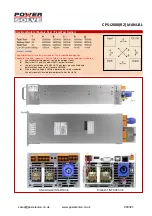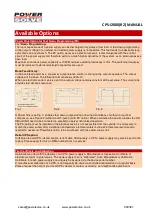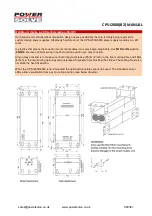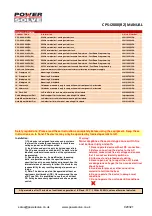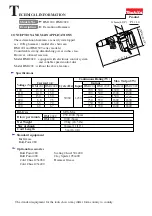
CPS-i2000(R2) MANUAL
LED Operating Signal
CV/OVP
CV Constant Voltage Mode LED lights Green
OVP Overvoltage maloperation or interference voltage LED lights Red
CC/OCP
CC Constant Current Mode LED lights Yellow
OCP Over Voltage Protection LED flashes Red, also see >>Fuse Mode<<
TA/OT
TA Temperature Alarm LED lights Yellow, warning temperature shutdown pending
OT Over Temperature Shutdown LED lights Red
INH/FF
INH Inhibit (Interlock) Shutdown LED lights Yellow
FF Fan Failure LED lights Red
SD/SB
SD Shutdown LED lights Yellow
SB Standby LED lights Red
Configuration of the Analogue Interface
Mode
S1
S2
S3
S4
S5
S6
S7
S8
S9
S10
S11
S12
0-5V
0
0
0
0
0
1
0
0
0
0
0-10V
0
1
0
0
1
0
0
1
1
1
0-20mA
1
1
0
1
1
0
0
1
1
1
4-20mA
1
0
1
1
0
0
1
1
1
1
CS active
0
CS non-active
1
Fuse Mode
0
Continuous Mode
1
Warning!
CS (Current Share Mode) only applies when a current distribution must take place while parallel
operation mode. In single or parallel operation without the need of CS, always switch CS with S11 to OFF=1.
Factory set: 0-10V Programming / CS non-active (S11=1), Continuous Mode (S12=1)
Programming/Monitoring V/C Analogue Interface (Ureg-IN/Ireg-IN) (Umon/Imon)
The standard programming of the CPS-i Series is an analog interface. The output voltage is linearly
proportional to the adjusted analog control signal. If the control signal 0V and/or 0A applies the power supply
delivers 0V at the output. The power supply is already working from 0V output voltage and low load with high
precision.
The monitor signal is analog linear to the output voltage. The monitor signal for current and voltage is the real
value that is measured directly at the output of the power supply. If a sense line is connected to compensate for
the voltage drop across the load lines, the monitor signal is exactly the value that is measured at the connection
point of the sense line. The description of the power supply in the sense operation is carried out in a separate
section.
The analog inputs and outputs are non-floating. The mass is connected to the DC negative output.
The adapter provides the ability to select the desired input / output via a DIP switch. The burden of the control
voltages is 1M
Ω
. The burden of the current interface is 500
Ω
. The latency to full compensation of V/C on the
interface from 0-100% is 15ms for all CPS-i models.
If the power supply is operated with a low load, the down-programming time up to the desired set point may be
very long. The power supply has large built-in capacitors and an enormous energy reserve. A similar effect
occurs by skidding input energy, which is not easily removed from the power supply. A PowerSink (PS) modul
can be ordered as an option for each CPS-i power supply unit. The PS option is used for fast down
programming and the degradation of skidding energy fed. The option must be equipped in the factory.
For further information about the PS option, please refer to the technical details in a separate section.
www.powersolve.co.uk
020321

















